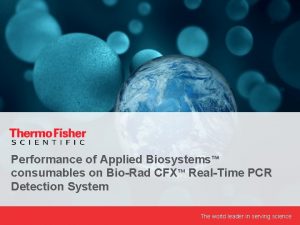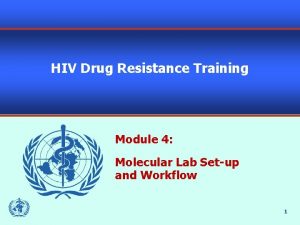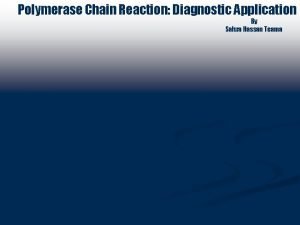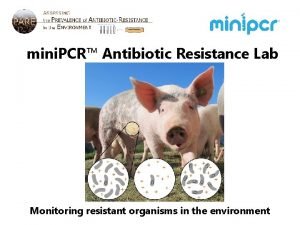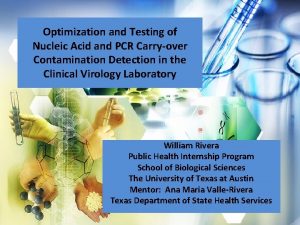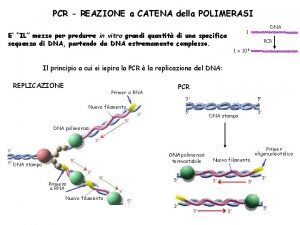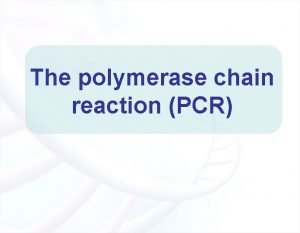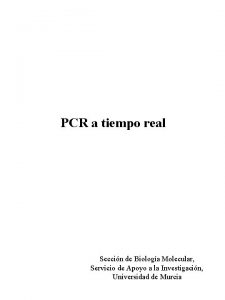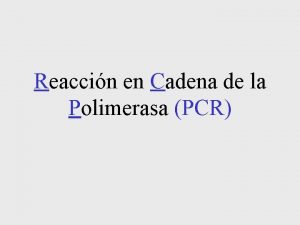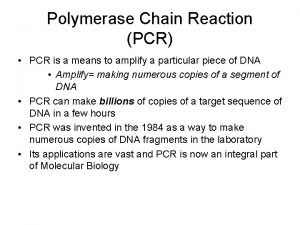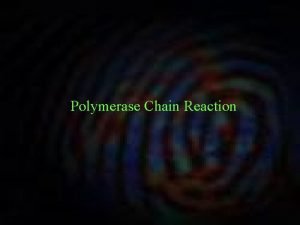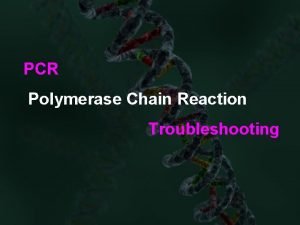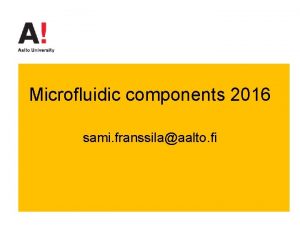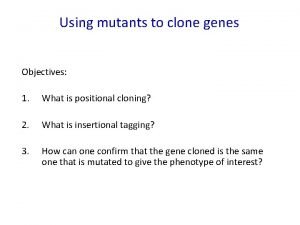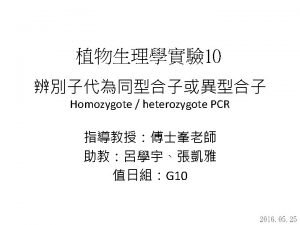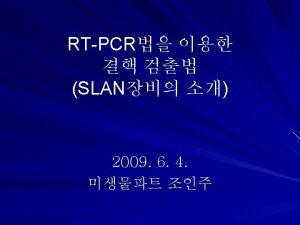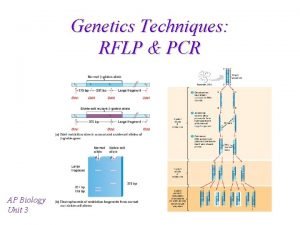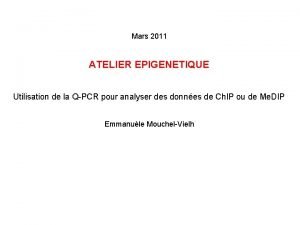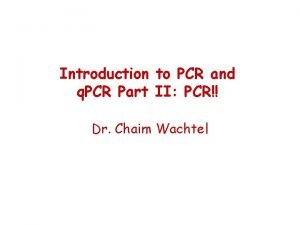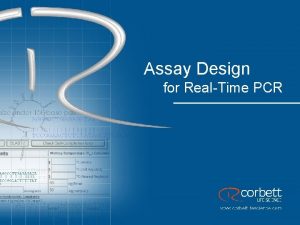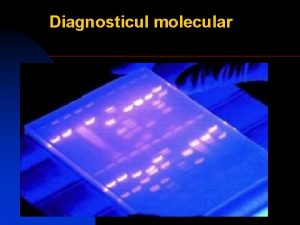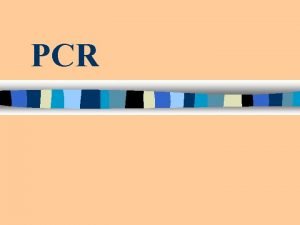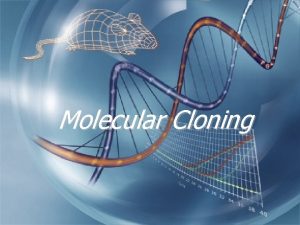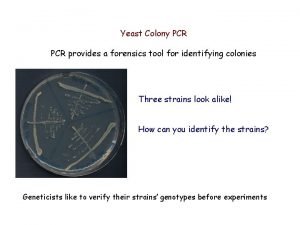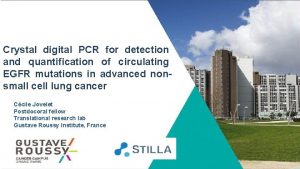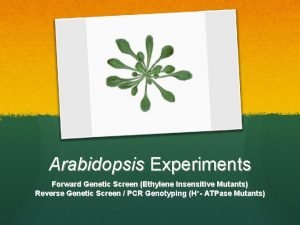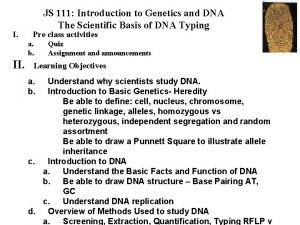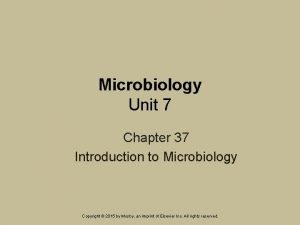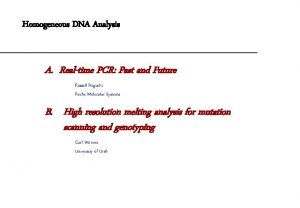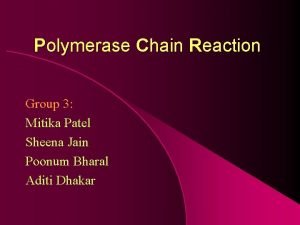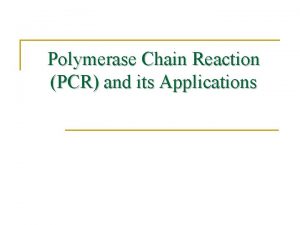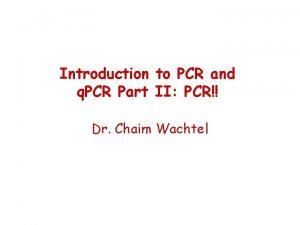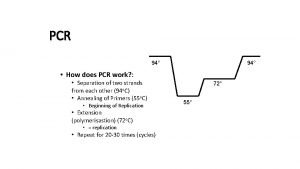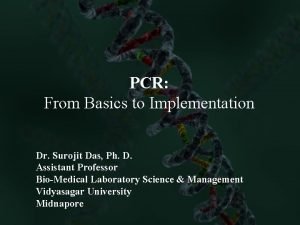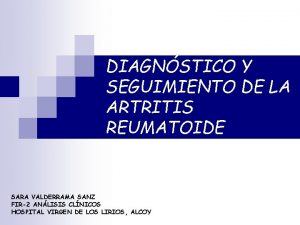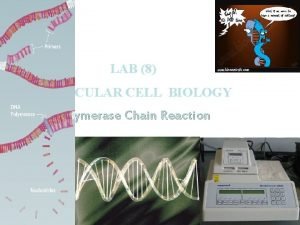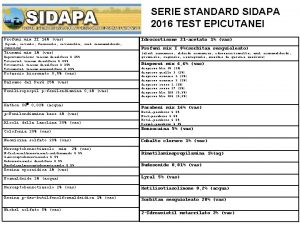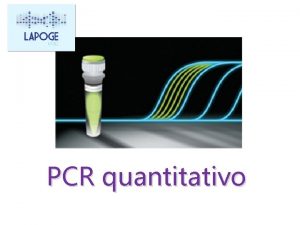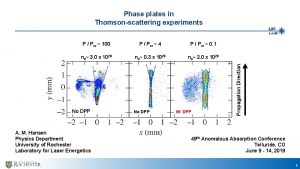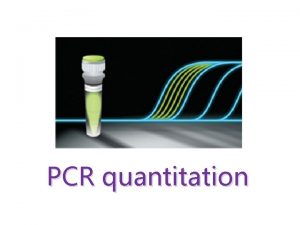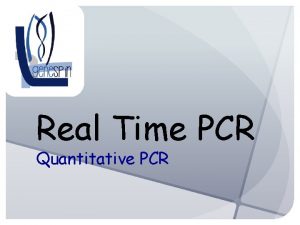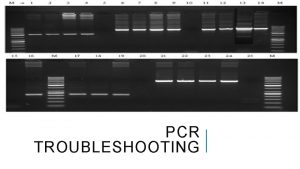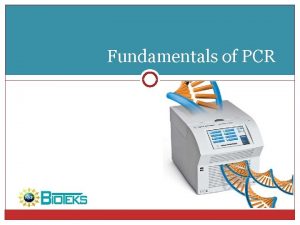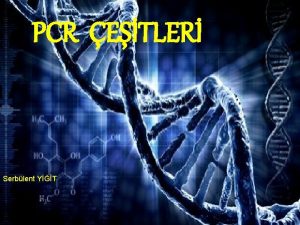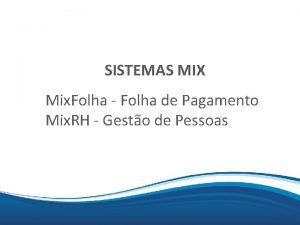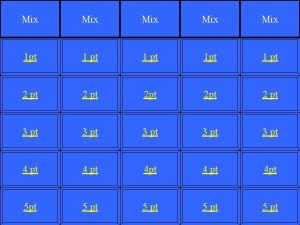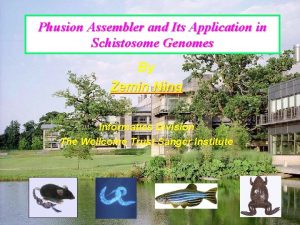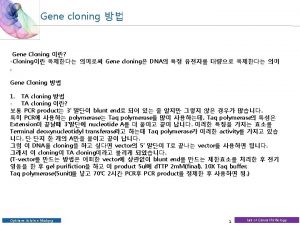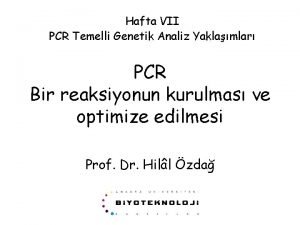1 2 3 4 5 Phusion PCR mix

























































































- Slides: 89

1. 2. 3. 4. 5. Phusion PCR mix: for 20 µl On ICE! Prepare 100 p. Mol/µl solutions of each of your primers with molecular grade water prepare 10 x dilution of F primer and add 2 µl to your PCR tube prepare 10 x dilution of R primer and add 2 µl to your PCR tube Add 1 µl of suitable genomic DNA Add 15 µl Phusion master mix (for 140 µl total volume) 1. 28 µl 5 x HF buffer 2. 2. 8 µl 10 m. M d. NTP 3. 1. 4 µl Phusion 4. 72. 8 µl molecular grade water

Cycle 1 x 60” @ 98˚ C 35 x: 30” @ 98˚ C : (55 -cycle #)” @ Topt : 1 min/1000 bp@ 72˚ C 1 x 5 ‘ @ 72˚ C Transfer 5 µl to fresh tube, add 1 µl dye & run on 2% gel

Cytoplasmic regulation • lifetime • localization • initiation

Post-transcriptional regulation Nearly ½ of human genome is transcribed, only 1% is CDS • 98% of RNA made is non-coding • ~1/3 intron • ~2/3 “independently transcribed” • Polymerases II & III (+ IV & V in plants) all help • many are from transposons or gene fragments made by transposons (pack-MULES) • ~ 10 -25% is anti-sense: same region is transcribed off both strands

Hypotheses 1. Accident: transcription unveils “cryptic promoters” on opposite strand (Zilberman et al) 2. Functional a. si. RNA b. mi. RNA c. Silencing d. Priming: chromatin remodeling requires transcription!

Post-transcriptional regulation RNA degradation is crucial with so much “extra” RNA

Post-transcriptional regulation RNA degradation is crucial with so much “extra” RNA • m. RNA lifespan varies 100 x • Highly regulated! > 30 RNAses in Arabidopsis!

Post-transcriptional regulation m. RNA degradation • lifespan varies 100 x • Sometimes due to AU-rich 3' UTR sequences (DST)

m. RNA degradation • lifespan varies 100 x • Sometimes due to AU-rich 3' UTR sequences (DST) • Endonuclease cuts DST, then exosome digests 3’->5’ & XRN 1 digests 5’->3’

m. RNA degradation • Most are degraded by de-Adenylation pathway • Deadenylase removes tail

m. RNA degradation • Most are degraded by de-Adenylation pathway • Deadenylase removes tail • Exosome digests 3’ -> 5’

m. RNA degradation • Most are degraded by de-Adenylation pathway • Deadenylase removes tail • Exosome digests 3’ -> 5’ • Or, decapping enz removes cap & XRN 1 digests 5’ ->3’

Post-transcriptional regulation m. RNA degradation: m. RNA is checked & defective transcripts are degraded = m. RNA surveillance 1. Nonsense-mediated decay: EJC @ each splice junction that is displaced by ribosome

Post-transcriptional regulation m. RNA degradation: m. RNA is checked & defective transcripts are degraded = m. RNA surveillance 1. Nonsense-mediated decay: EJC @ each splice junction that is displaced by ribosome 2. If not-displaced, is cut by endonuclease & RNA is degraded

Post-transcriptional regulation m. RNA degradation: m. RNA is checked & defective transcripts are degraded = m. RNA surveillance Non-stop decay: Ribosome goes to end & cleans off PABP

Post-transcriptional regulation m. RNA degradation: m. RNA is checked & defective transcripts are degraded = m. RNA surveillance Non-stop decay: Ribosome goes to end & cleans off PABP w/o PABP exosome eats m. RNA

Post-transcriptional regulation m. RNA degradation: m. RNA is checked & defective transcripts are degraded = m. RNA surveillance No-go decay: cut RNA 3’ of stalled ribosomes

Post-transcriptional regulation m. RNA degradation • lifespan varies 100 x • Sometimes due to AU-rich 3' UTR sequences • Defective m. RNA may be targeted by NMD, NSD, NGD Other RNA are targeted by small interfering RNA

Post-transcriptional regulation Other m. RNA are targeted by small interfering RNA • defense against RNA viruses • DICERs cut ds. RNA into 21 -28 bp

Post-transcriptional regulation Other m. RNA are targeted by small interfering RNA • defense against RNA viruses • DICERs cut ds. RNA into 21 -28 bp • helicase melts ds. RNA

Post-transcriptional regulation Other m. RNA are targeted by small interfering RNA • defense against RNA viruses • DICERs cut ds. RNA into 21 -28 bp • helicase melts ds. RNA • - RNA binds RISC

Post-transcriptional regulation Other m. RNA are targeted by small interfering RNA • defense against RNA viruses • DICERs cut ds. RNA into 21 -28 bp • helicase melts ds. RNA • - RNA binds RISC • complex binds target

Post-transcriptional regulation Other m. RNA are targeted by small interfering RNA • defense against RNA viruses • DICERs cut ds. RNA into 21 -28 bp • helicase melts ds. RNA • - RNA binds RISC • complex binds target • target is cut

Cytoplasmic regulation Small RNA regulation • si. RNA: target RNA viruses (& transgenes) • mi. RNA: arrest translation of targets • created by digestion of foldback Pol II RNA with mismatch loop

Cytoplasmic regulation Small RNA regulation • si. RNA: target RNA viruses (& transgenes) • mi. RNA: arrest translation of targets • created by digestion of foldback Pol II RNA with mismatch loop • Mismatch is key difference: generated by different Dicer

Cytoplasmic regulation Small RNA regulation • si. RNA: target RNA viruses (& transgenes) • mi. RNA: arrest translation of targets • created by digestion of foldback Pol II RNA with mismatch loop • Mismatch is key difference: generated by different Dicer • Arrest translation in animals, target degradation in plants

small interfering RNA mark specific targets • once cut they are removed by endonuclease-mediated decay


Most RNA degradation occurs in P bodies • recently identified cytoplasmic sites where exosomes & XRN 1 accumulate when cells are stressed

Most RNA degradation occurs in P bodies • recently identified cytoplasmic sites where exosomes & XRN 1 accumulate when cells are stressed • Also where AGO & mi. RNAs accumulate

Most RNA degradation occurs in P bodies • recently identified cytoplasmic sites where exosomes & XRN 1 accumulate when cells are stressed • Also where AGO & mi. RNAs accumulate • w/o mi. RNA P bodies dissolve!

Post-transcriptional regulation 1) m. RNA processing 2) export from nucleus 3) m. RNA degradation 4) m. RNA localization • RNA-binding proteins link it to cytoskeleton: bring it to correct site or store it

4) m. RNA localization • RNA-binding proteins link it to cytoskeleton: bring it to correct site or store it • Some RNA (eg Knotted) are transported into neighboring cells

4) m. RNA localization • RNA-binding proteins link it to cytoskeleton: bring it to correct site or store it • Some RNA are transported into neighboring cells • Others are transported t/o the plant in the phloem (SUT 1, KN 1)

4) m. RNA localization • RNA-binding proteins link it to cytoskeleton: bring it to correct site or store it • Some RNA are transported into neighboring cells • Others are transported t/o the plant in the phloem (SUT 1, KN 1) • Also some si. RNA & mi. RNA!

4) m. RNA localization • RNA-binding proteins link it to cytoskeleton: bring it to correct site or store it • Some RNA are transported into neighboring cells • Others are transported t/o the plant in the phloem (SUT 1, KN 1) • Also some si. RNA & mi. RNA! • si. RNA mediate silencing • Especially of viruses & TE

4) m. RNA localization • RNA-binding proteins link it to cytoskeleton: bring it to correct site or store it • Some RNA are transported into neighboring cells • Others are transported t/o the plant in the phloem (SUT 1, KN 1) • Also some si. RNA & mi. RNA! • si. RNA mediate silencing • Mi. R 399 moves to roots to destroy PHO 2 m. RNA upon Pi stress • PHO 2 negatively regulates Pi uptake

Post-transcriptional regulation RNA in pollen controls first division after fertilization!

Post-transcriptional regulation RNA in pollen controls first division after fertilization! Delivery by pollen ensures correct development doesn’t happen unless egg is fertilized by pollen

Post-transcriptional regulation 4) m. RNA localization • RNA-binding proteins link it to cytoskeleton: bring it to correct site or store it • many are stored in P-bodies! More than just an RNAdestruction site

Post-transcriptional regulation 4) m. RNA localization • RNA-binding proteins link it to cytoskeleton: bring it to correct site or store it • many are stored in P-bodies! More than just an RNAdestruction site • Link with initiation of translation

Post-transcriptional regulation Protein degradation rate varies 100 x • Some have motifs, eg Destruction box, marking them for polyubiquitination: taken to proteasome & destroyed

Post-transcriptional regulation Protein degradation rate varies 100 x • Some have motifs, eg Destruction box, marking them for polyubiquitination: taken to proteasome & destroyed • N-terminal rule: Proteins with N-terminal Phe, Leu, Asp, Lys, or Arg have half lives of 3 min or less.

Post-transcriptional regulation Protein degradation rate varies 100 x • Some have motifs, eg Destruction box, marking them for polyubiquitination: taken to proteasome & destroyed • N-terminal rule: Proteins with N-terminal Phe, Leu, Asp, Lys, or Arg have half lives of 3 min or less. • Proteins with N-terminal Met, Ser, Ala, Thr, Val, or Gly have half lives greater than 20 hours.

Protein degradation Some have motifs marking them for polyubiquitination: • E 1 enzymes activate ubiquitin • E 2 enzymes conjugate ubiquitin • E 3 ub ligases determine specificity, eg for N-terminus

Protein degradation Some have motifs marking them for polyubiquitination: • E 1 enzymes activate ubiquitin • E 2 enzymes conjugate ubiquitin • E 3 ub ligases determine specificity, eg for N-terminus Discovered in plants: X-W Deng found COP 1 mutant • Looks like light-grown plant in dark: tags proteins for destruction

Protein degradation • E 3 ub ligases determine specificity • >1300 E 3 ligases in Arabidopsis • 4 main classes according to cullin scaffolding protein

E 3 ubiquitin ligases determine specificity >1300 E 3 ligases in Arabidopsis 4 main classes according to cullin scaffolding protein • RBX 1 (or similar) positions E 2

E 3 ubiquitin ligases determine specificity >1300 E 3 ligases in Arabidopsis 4 main classes according to cullin scaffolding protein • RBX 1 (or similar) positions E 2 • Linker (eg DDB 1) positions substrate receptor

E 3 ubiquitin ligases determine specificity >1300 E 3 ligases in Arabidopsis 4 main classes according to cullin scaffolding protein • RBX 1 (or similar) positions E 2 • Linker (eg DDB 1) positions substrate receptor • Substrate receptor (eg DCAF/DWD) picks substrate • >100 DWD in Arabidopsis

E 3 ubiquitin ligases determine specificity >1300 E 3 ligases in Arabidopsis 4 main classes according to cullin scaffolding protein • RBX 1 (or similar) positions E 2 • Linker (eg DDB 1) positions substrate receptor • Substrate receptor (eg DCAF/DWD) picks substrate • NOT 4 is an E 3 ligase & a component of the CCR 4–NOT de-A complex

E 3 ubiquitin ligases determine specificity >1300 E 3 ligases in Arabidopsis 4 main classes according to cullin scaffolding protein • RBX positions E 2 • DDB 1 positions DCAF/DWD • DCAF/DWD picks substrate: >85 DWD in rice • NOT 4 is an E 3 ligase & a component of the CCR 4–NOT de-A complex • CCR 4–NOT de-A Complex regulates pol II

E 3 ubiquitin ligases determine specificity >1300 E 3 ligases in Arabidopsis 4 main classes according to cullin scaffolding protein • RBX positions E 2 • DDB 1 positions DCAF/DWD • DCAF/DWD picks substrate • NOT 4 is an E 3 ligase & a component of the CCR 4–NOT de-A complex • CCR 4–NOT de-A Complex regulates pol II • Transcription, m. RNA deg & prot deg are linked!

E 3 ubiquitin ligases determine specificity Cell cycle: Anaphase Promoting Complex is an E 3 ligase. MPF induces APC inactive until all kinetochores are bound APC then tags securin to free separase: cuts proteins linking chromatids

E 3 ubiquitin ligases determine specificity MPF induces APC inactive until all kinetochores are bound APC then tags securin to free separase: cuts proteins linking chromatids APC next swaps Cdc 20 for Cdh 1 & tags cyclin B to enter G 1

E 3 ubiquitin ligases determine specificity APC next tags cyclin B (destruction box) to enter G 1 APC also targets Sno proteins in TGF-b signaling • Sno proteins prevent Smad from activating genes

E 3 ubiquitin ligases determine specificity APC also targets Sno proteins in TGF-b signaling • Sno proteins prevent Smad from activating genes • APC/Smad 2/Smad 3 tags Sno for destruction

E 3 ubiquitin ligases determine specificity APC also targets Sno proteins in TGF-b signaling • Sno proteins prevent Smad from activating genes • APC/Smad 2/Smad 3 tags Sno for destruction • Excess Sno = cancer

E 3 ubiquitin ligases determine specificity APC also targets Sno proteins in TGF-b signaling • Sno proteins prevent Smad from activating genes • APC/Smad 2/Smad 3 tags Sno for destruction • Excess Sno = cancer Angelman syndrome = bad UBE 3 A • Only express maternal allele because paternal allele is methylated

Auxin signaling Auxin receptors eg TIR 1 are E 3 ubiquitin ligases Upon binding auxin they activate complexes targeting AUX/IAA proteins for degradation

Auxin signaling Auxin receptors eg TIR 1 are E 3 ubiquitin ligases! Upon binding auxin they activate complexes targeting AUX/IAA proteins for degradation AUX/IAA inhibit ARF transcription factors, so this turns on "early genes"

Auxin signaling Auxin receptors eg TIR 1 are E 3 ubiquitin ligases! Upon binding auxin they activate complexes targeting AUX/IAA proteins for degradation! AUX/IAA inhibit ARF transcription factors, so this turns on "early genes" Some early genes turn on 'late genes" needed for development

DWD Proteins Jae-Hoon Lee’s research • putative substrate receptors for CUL 4 -based E 3 ligases

DWD Proteins Jae-Hoon Lee’s research • putative substrate receptors for CUL 4 -based E 3 ligases • used bioinformatics to find all Arabidopsis & rice DWDs

DWD Proteins • used bioinformatics to find all Arabidopsis & rice DWDs • Placed in subgroups based on DWD sequence

DWD Proteins • used bioinformatics to find all Arabidopsis & rice DWDs • Placed in subgroups based on DWD sequence • Tested members of each subgroup for DDB 1 binding

DWD Proteins • Tested members of each subgroup for DDB 1 binding • co-immunoprecipitation

DWD Proteins • Tested members of each subgroup for DDB 1 binding • co-immunoprecipitation • Two-hybrid: identifies interacting proteins

DWD Proteins • Tested members of each subgroup for DDB 1 binding • co-immunoprecipitation • Two-hybrid: identifies interacting proteins • Only get transcription if one hybrid supplies Act D & other supplies DNA Binding Domain

DWD Proteins Two-hybrid libraries are used to screen for protein-protein interactions

DWD Proteins • Tested members of each subgroup for DDB 1 binding • co-immunoprecipitation • Two-hybrid

DWD Proteins • Tested members of each subgroup for DDB 1 binding • co-immunoprecipitation • Cul 4 cs &PRL 1 (Pleiotropic Regulatory Locus 1) had Similar phenotypes

DWD Proteins Cul 4 cs &PRL 1 (Pleiotropic. Regulatory Locus 1) had similar phenotypes PRL 1 may be receptor for AKIN 10 degradation (involved in sugar sensing)

DWD Proteins • Found T-DNA insertions • 3 were sensitive to ABA

DWD Proteins • Found T-DNA insertions • 3 were sensitive to ABA • ABI 5 was elevated in dwa mutants

DWD Proteins • Found T-DNA insertions • 3 were sensitive to ABA • ABI 5 was elevated in dwa mutants • ABI 5 was degraded more slowly in dwa extracts

DWD Proteins • Found T-DNA insertions • 3 were sensitive to ABA • ABI 5 was elevated in dwa mutants • ABI 5 was degraded more slowly in dwa extracts • DWA 1 & DWA 2 target ABI 5 for degradation

Regulating E 3 ligases The COP 9 signalosome (CSN), a complex of 8 proteins, regulates E 3 ligases by removing Nedd 8 from cullin

Regulating E 3 ligases The COP 9 signalosome (CSN), a complex of 8 proteins, regulates E 3 ligases by removing Nedd 8 from cullin CAND 1 then blocks cullin

Regulating E 3 ligases The COP 9 signalosome (CSN), a complex of 8 proteins, regulates E 3 ligases by removing Nedd 8 from cullin CAND 1 then blocks cullin Ubc 12 replaces Nedd 8

Regulating E 3 ligases The COP 9 signalosome (CSN), a complex of 8 proteins, regulates E 3 ligases by removing Nedd 8 from cullin CAND 1 then blocks cullin Ubc 12 replaces Nedd 8 Regulates DNA-damage response, cell-cycle & gene expression

Regulating E 3 ligases The COP 9 signalosome (CSN), a complex of 8 proteins, regulates E 3 ligases by removing Nedd 8 from cullin CAND 1 then blocks cullin Ubc 12 replaces Nedd 8 Regulates DNA-damage response, cell-cycle & gene expression Not all E 3 ligases associate with Cullins!

• • COP 1 is a non-cullin-associated E 3 ligase Protein degradation is important for light regulation COP 1/SPA 1 tags transcription factors for degradation W/O COP 1 they act in dark In light COP 1 is exported to cytoplasm so TF can act

COP 1 is a non-cullin-associated E 3 ligase • Recent data indicates that COP 1 may also associate with CUL 4

Protein degradation rate varies 100 x Most have motifs marking them for polyubiquitination: taken to proteosome & destroyed Other signals for selective degradation include PEST & KFERQ • PEST : found in many rapidly degraded proteins • e. g. ABCA 1 (which exports cholesterol in association with apo. A-I) is degraded by calpain

Protein degradation rate varies 100 x Other signals for selective degradation include PEST & KFERQ • PEST : found in many rapidly degraded proteins • e. g. ABCA 1 (which exports cholesterol in association with apo. A-I) is degraded by calpain • Deletion increases t 1/2 10 x, adding PEST drops t 1/2 10 x

Protein degradation rate varies 100 x Other signals for selective degradation include PEST & KFERQ • PEST : found in many rapidly degraded proteins • e. g. ABCA 1 (which exports cholesterol in association with apo. A-I) is degraded by calpain • Deletion increases t 1/2 10 x, adding PEST drops t 1/2 10 x • Sometimes targets poly-Ub

Protein degradation rate varies 100 x Other signals for selective degradation include PEST & KFERQ • PEST : found in many rapidly degraded proteins • e. g. ABCA 1 (which exports cholesterol in association with apo. A-I) is degraded by calpain • Deletion increases t 1/2 10 x, adding PEST drops t 1/2 10 x • Sometimes targets poly-Ub • Recent yeast study doesn’t support general role

Protein degradation rate varies 100 x Other signals for selective degradation include PEST & KFERQ • PEST : found in many rapidly degraded proteins • e. g. ABCA 1 (which exports cholesterol in association with apo. A-I) is degraded by calpain • Deletion increases t 1/2 10 x, adding PEST drops t 1/2 10 x • Sometimes targets poly-Ub • Recent yeast study doesn’t support general role • KFERQ: cytosolic proteins with KFERQ are selectively taken up by lysosomes in chaperone-mediated autophagy under conditions of nutritional or oxidative stress.
 Biorad pcr master mix
Biorad pcr master mix Product mix vs product line
Product mix vs product line Pcr primeros auxilios
Pcr primeros auxilios Alu pcr
Alu pcr Pcr documentation
Pcr documentation Touchdown bp
Touchdown bp Molecular lab setup and workflow
Molecular lab setup and workflow Xét nghiệm pcr
Xét nghiệm pcr Conventional pcr
Conventional pcr Pcr phases
Pcr phases Minipcr antibiotic resistance lab
Minipcr antibiotic resistance lab Pcr nobel prize
Pcr nobel prize Advantages of pcr technique
Advantages of pcr technique Cicli pcr
Cicli pcr Applications of pcr
Applications of pcr Pcr copies
Pcr copies Fase plateau pcr
Fase plateau pcr Rafinable
Rafinable Pcr tiempo real y punto final
Pcr tiempo real y punto final Pcr annealing temperature too high
Pcr annealing temperature too high Advantages of pcr
Advantages of pcr Pcr
Pcr Application of pcr
Application of pcr Technika pcr
Technika pcr What is restriction digestion
What is restriction digestion Edta tube
Edta tube Pcr
Pcr Pcr troubleshooting multiple bands
Pcr troubleshooting multiple bands Pcr
Pcr Pcr process change request
Pcr process change request Advantages of pcr technique
Advantages of pcr technique Dairyland ssd
Dairyland ssd Inverse pcr
Inverse pcr Pcr
Pcr Pcr wikiskripta
Pcr wikiskripta Slan real time pcr
Slan real time pcr Pcr rflp animation
Pcr rflp animation Calcul efficacité pcr quantitative
Calcul efficacité pcr quantitative Pcr définition
Pcr définition Pcr q
Pcr q 5t e 5h da pcr
5t e 5h da pcr Pcr
Pcr Rt pcr primer design tool
Rt pcr primer design tool Reactia pcr
Reactia pcr Fase plateau pcr
Fase plateau pcr Objectives of pcr
Objectives of pcr Pcr gif animation
Pcr gif animation Illustration of the steps in restriction digestion and pcr
Illustration of the steps in restriction digestion and pcr Yeast colony pcr
Yeast colony pcr Crystal digital pcr
Crystal digital pcr Pcr q
Pcr q Ethylene oxide pcr tests
Ethylene oxide pcr tests Pcr ppt
Pcr ppt Conventional pcr
Conventional pcr Microbiology
Microbiology Tail pcr principle
Tail pcr principle Pcr abi
Pcr abi Purpose of pcr
Purpose of pcr Polymerase chain reaction application
Polymerase chain reaction application Primer dimer
Primer dimer Advantages of pcr technique
Advantages of pcr technique Test pcr melle
Test pcr melle Pcr profile
Pcr profile Applications of pcr
Applications of pcr Pcr
Pcr Applications of pcr
Applications of pcr Valores de pcr en artritis reumatoide
Valores de pcr en artritis reumatoide Pcr technique
Pcr technique Fases pcr
Fases pcr Dna replication vs pcr
Dna replication vs pcr Product line example
Product line example Customer mix
Customer mix 4v marketing mix
4v marketing mix 10 p marketing mix
10 p marketing mix Carefully blended mix of promotion tools
Carefully blended mix of promotion tools Managing integrated marketing communication process
Managing integrated marketing communication process Marketingový mix neziskových organizací
Marketingový mix neziskových organizací Retail strategy mix
Retail strategy mix Mix and a mingle in the jingling feet
Mix and a mingle in the jingling feet Tears crushes and mashes food
Tears crushes and mashes food Gic type 1
Gic type 1 Is code 10262 latest revision
Is code 10262 latest revision Promotional techniques
Promotional techniques Test epicutanei serie standard
Test epicutanei serie standard Analisis swot pisang coklat
Analisis swot pisang coklat Gatorade marketing mix
Gatorade marketing mix Above the line promotion examples
Above the line promotion examples Uscp deck mix ae
Uscp deck mix ae Microfinance information exchange
Microfinance information exchange Retail institutions by store-based strategy mix
Retail institutions by store-based strategy mix
